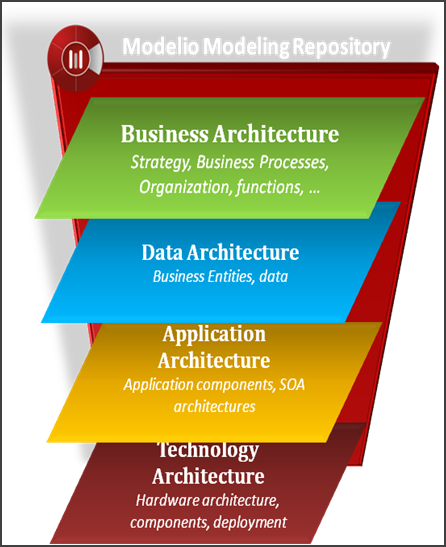hi
some definitions about EA again
what is Enterprise Architecture?
Enterprise Architecture (EA) is a discipline that has gained and will continue to gain huge importance to master enterprise organization and its IT support.
Enterprise Architecture is a complete expression of the enterprise, a master plan which “acts as a collaboration force” between aspects of business planning (such as goals, visions, strategies and governance principles), aspects of business operations (such as business terms, organization structures, processes and data), aspects of automation (such as information systems and databases) and the enabling technological infrastructure of the business (such as computers, operating systems and networks).
Enterprise architects use various business methods, analytical techniques and conceptual tools to understand and document the structure and dynamics of an enterprise. In doing so, they produce lists, drawings, documents and models, together called "artifacts". These artifacts describe the logical organization of business functions, business capabilities, business processes, people, information resources, business systems, software applications, computing capabilities, information exchange and communications infrastructure within the enterprise.
Enterprise Architecture Domains?
Enterprise Architecture Domains
Several enterprise architecture frameworks break down the practice of enterprise architecture into a number of practice areas or "domains" (also called viewpoints, layers or aspects).
- There are at least two domains, "Business Modeling" and "Current Systems and Technology", which can be further broken down into "Data Architecture", "Applications Architecture" and "Technology Architecture".
- The popular TOGAF framework divides the practice into three domains, "Business Architecture", "Information Systems Architecture" and "Technology Architecture" and then subdivides the information systems architecture into "Information Architecture" and "Applications Architecture".
- The Strategic Architecture Model allows for a flexible division into up to ten domains covering many aspects of an enterprise from its objectives and goals through its projects and programs to its software applications and technology.
The dividing of the practice into a number of domains allows enterprise architects to describe an enterprise from a number of important perspectives, dividing the descriptive task between many participants and allowing the practice as a whole to make good use of individual domain-specific expertise and knowledge. By taking this approach, enterprise architects can ensure a holistic description of the design of the enterprise is produced.
Enterprise Architecture Techniques
Business techniques
- Vision: Goals, Strategy
- Organization, Organization units, Geographical distribution
- Business processes
- Business models, Business Rules, Key Business Concepts
Application techniques
- Inventory of software applications
- Inventory of repositories
- Software application interfaces, events, messages, dataflows
- Intra/Extra-net, eCommerce, EDI, internal and external links between organizations
- Data models
Technical techniques
- Hardware, networks, servers
- Software infrastructure: Application servers, RDB, etc
Enterprise Architecture Standards
Standards such as TOGAF, MODAF, DODAF provide definitions and predefined viewpoints for enterprise architecture. There also exist open methodologies such as PRAXEME (www.praxeme.org) that specify how to model and realize enterprise architecture. A wide diversity of tools and company-specific practices for enterprise architecture development exist.

Modelio's Support for Enterprise Architecture
Modelio integrates the entire set of models necessary to cover the whole scope of Enterprise Architecture. It supports goal analysis through its Analyst module, which also provides support for business rules and domain dictionaries. The Enterprise Architect Solution provides dedicated Enterprise Architecture modeling support by integrating UML and BPMN, in order to provide both integrated business process modeling support and TOGAF-dedicated modeling support.
The support Modelio provides is based on well-defined standards (UML, BPMN, TOGAF, BMM). Enterprise Architecture extensions are added to this using the UML profile technique. Modelio offers dedicated diagrams for modeling organization, business process maps, application maps, SOA architecture views, etc.
Modelio provides a unique repository for all aspects of Enterprise Architecture, thus helping to achieve the Enterprise Continuum recommended by TOGAF.
http://www.modeliosoft.com/en/technologies/enterprise-architecture.html
;;_))

No hay comentarios:
Publicar un comentario